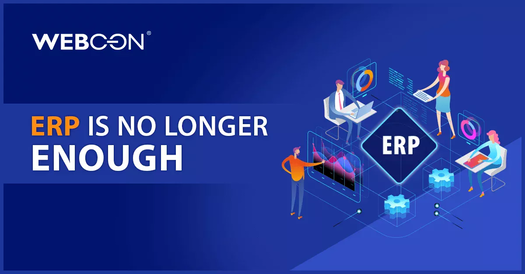WEBCON BPS is a fantastic process-forward low-code platform for building business solutions. But for 14 years, we’ve been using that platform to enhance Microsoft platforms. It started with SharePoint, but as the Office platform has expanded, so has WEBCON BPS.


1. It brings a best-of-breed business process engine to Microsoft 365
Yes, best of breed — we’re going there.
WEBCON BPS is a true process engine. It’s focused on the overall stages where a business process can go, who is responsible for them, which options are possible, and what should happen as those options occur. It factors in auditing, preserving state when migrating/archiving, and more.
In contrast, every workflow engine that has been supplied “in the box” (Windows Workflow Foundation, Workflow Manager, Power Automate) has been focused on automating tasks, executing batches of steps, etc. That’s important, and very much needed — but it’s not the same.
In truth, you need both task automation and business process management. People take part in business processes every day, but by adding WEBCON BPS, those processes become modeled, governed, managed, audited, measured, and continuously improved.
2. Your applications appear as natural-looking parts of SharePoint, Teams, and other Microsoft 365 ecosystem technology
You’ve been able to present WEBCON BPS applications inside of SharePoint sites for 14 years. WEBCON BPS began life as a SharePoint service application. But when SharePoint pivoted to the cloud as part of Office 365, we pivoted to match, and followed Microsoft’s guidelines about how modern applications should integrate with it.
And when we did so, it became possible to surface WEBCON BPS applications in lots of additional places. You can see a WEBCON BPS application (its dashboards, reports, data views, charts, forms, etc.) inside of Teams. Inside of Outlook (in Windows, macOS, iOS, Android, and any web browser). Custom web applications, and mobile devices, too.
Your users can use your handiwork wherever they’re comfortable working. WEBCON BPS is everywhere.
3. It offers a new kind of data container to Microsoft 365 that combines the best of lists, libraries, and even sites
Every WEBCON BPS workflow instance is a case folder. What’s a case folder? Assuming you’re well-versed in Office 365, start with a document set, and then:
- Add embedded sublists.
- Add an embedded discussion list.
- Add an additional sub-list for storing email attachments.
- Add an audit trail for every change made to any document, row, field, etc.
- Let the components on the form cache the data they fetch from other places so that can be audited, too.
- Make it so one set of permissions governs every asset.
- Generate a custom form for the whole thing and make it adapt any time there’s a change.
- Attach a process map to it so you can react to changes to any of it, including when someone opens it or tries to delete it.
- Make each of these easy to archive.
- Support transactions, so the data never gets out of sync.
- Include task assignments and responsibilities as part of the store and the audit trail.
You could build an application out of a loose coupling of multiple lists, libraries, pages, log files, etc. Or you could just use cases and both save yourself a lot of time and gain a lot of power in the process.
Cases also let your workflow react to a lot more than just inserts and updates. WEBCON BPS processes know when items are being deleted, when attachments are being added/removed, when someone is opening a form, and more.
Cases are stored in SQL Server, appear within SharePoint sites as web parts and within Teams as tabs. They look like a new kind of list. You can treat them as a new kind of list. And you’ll be better off for doing it.
4. You can make Microsoft 365 assets with it
WEBCON has been working with Microsoft technology longer than many companies and products have been around. We’ve never stopped looking at, and adapting to, the kinds of things customers and partners want to automate. Just a few examples of this include.
- Creating/deleting/updating SharePoint (Server and Online) lists and libraries. And list items. And documents. And permissions. And groups.
- Reading data from Excel worksheets and writing data into them.
- Generating Word documents from process data, and turning them into PDF files, too.
- Creating and updating Exchange (Server and Online) calendars, Out-of-the-Office replies, and tasks.
- Using both Microsoft Graph API and PowerShell scripts to get at virtually any administrative and/or user asset.
5. It makes your custom solutions in Microsoft 365 easier to create, easier to deploy, and much, much, much easier to change
A WEBCON BPS application is a complete set of interconnected assets. Forms? Workflows? Data? Reports? Dashboards? Permissions? Connections? Data Sources? Rules? Templates? You build them together. They automatically know about each other. You deploy them together.
By comparison, many alternatives are, well, fragile. You can break some forms by changing the underlying data. You can break some workflows by changing a form field. WEBCON BPS doesn’t have these problems.
And since there is no business productivity application that doesn’t – legitimately – need regular evaluation and adaptation, changing an application needs to be a smooth, steady process. WEBCON’s trademarked InstantChange™ technology ensures that modifications to an application happen immediately, and without disruption. You can push out changes that take effect everywhere. You don’t have to recall/restart work in progress, nor do you have to accept that it will finish in an obsolete state.
Moreover, you can publish an application once and have it appear in multiple sites/teams – without having to create a unique copy of it for each target location.
In conclusion
WEBCON BPS can be used to build process-centric low-code applications that can be deployed anywhere. But they were designed from day one to work well within SharePoint environments, and over the years, that philosophy has expanded to include much of the Microsoft 365 stack.
It’s the perfect technology to transform teams and sites from places where work is put into places where work is done.
Watch how WEBCON BPS makes Microsoft 365 better:









